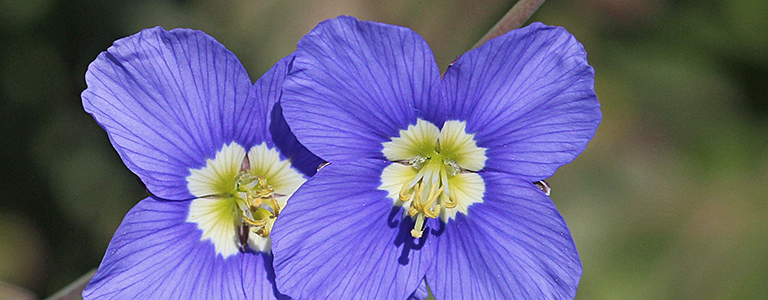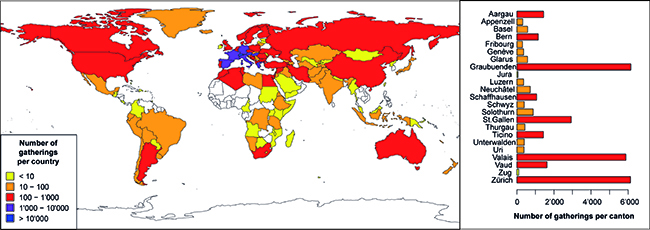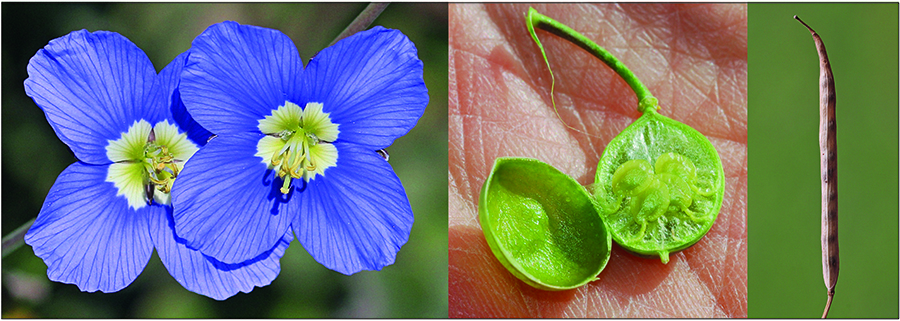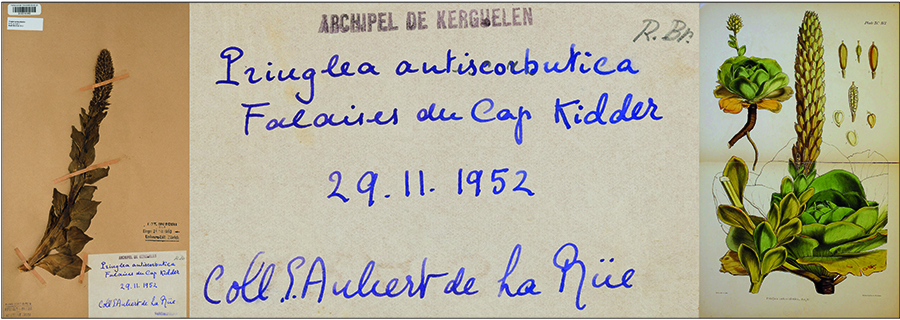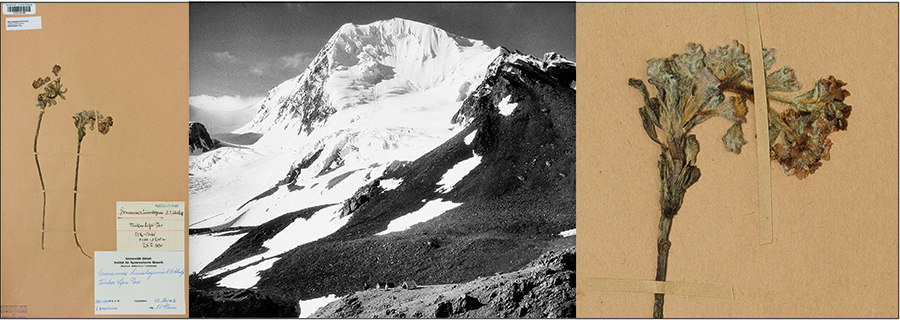What are crucifers? Where do they occur? And which role do they play in today’s research? The digitised holdings of the United Herbaria of the University (Z) and ETH (ZT) Zurich offer some answers.
Crucifers (in Latin Brassicaceae) encompass both culinary delicacies such as kale, rocket, watercress, mustard or wasabi, and superstars of plant genetics, which became indispensable for daily research. Some taste spicy, others develop a delicate garlic aroma, but all accumulate sulfur-containing glycosides in their cells, which can be released as chemical weapons against herbivores (e.g. phytophagous insects) when being damaged. The thale cress (Arabidopsis thaliana) reached particular fame in the natural sciences, because it is small-sized, has a tiny genome, can be found all over the world and undergoes its life cycle within two months, all of these properties being ideal for large-scale laboratory experiments.
The United Herbaria Z+ZT house nearly 82,000 specimens of Brassicaceae from 125 different countries, but 55% of the collection is from Switzerland. At the national level, most of the specimens were collected in the cantons of Grisons, Valais and Zurich (© A. Guggisberg, unpublished data).
The crucifers comprise about 4,000, mostly herbaceous species, which mainly occur in the temperate zone of the northern hemisphere. With a total of 1,626 species, the Z+ZT collection houses more than a third of the world’s biodiversity. Morphologically, Brassicaceae are easy to recognise on the basis of their four “crossed” petals, which embrace four long and two short stamens, the reason why Antoine-Laurent de Jussieu (1748-1836) first named them Cruciferae in 1789. Their characteristic dehiscent fruits called siliques, however, are very variable and of great importance in plant identification. Here, one should always pay attention to the ratio between width and length of the fruits, and, in case of so-called short silicles, assess the position of the septum to the fruit walls.
Typical flower shape (on the left) in Heliophila coronopifolia (© G. Mansion, 24.08.2017), as well as divergent fruit forms between Alyssoides utricularia (in the middle; © A. Guggisberg, 29.04.2015) and Brassica napus (on the right; © G. Mansion, 08.07.2019).
Natural history collections provide insights into the distribution of biological diversity in time and space, be it for taxonomic investigations or the compilation of floras. Specimens of the Kerguelen cabbage (Pringlea antiscorbutica) from the eponymous, subantarctic island archipelago prove to be the remotest sampling location in the Z+ZT collection. After its discovery in 1776, during the third voyage of James Cook (1728-1779), this plant was massively harvested as a remedy against scurvy by seafarers, e.g. James Clark Ross (1800-1862) on his expedition to Antarctica, for its high vitamin C content. Today, it is threatened by introduced rabbits and global warming, but the recent entry of its habitat on the list of UNESCO World Heritage sites raises hope for the future.
Specimen of Pringlea antiscorbutica from the Kerguelen archipelago (on the left) with zoom on label (in the middle; Z-000164352, United Herbaria Z+ZT, CC BY-SA 4.0). The drawing (on the right) is from Joseph Dalton Hooker (1817-1911), who named this species in 1844 in honour of the British military physician John Pringle (1707-1782; J.D. Hooker, 1844, CC0).
The above specimen was collected in 1952 by the French-Swiss geologist Edgar Aubert de la Rüe (1901-1991) during his fourth voyage to the French Southern and Antarctic Territories and bears testament to the great historical value of such herbaria. The Swiss geologist Arnold Heim (1882-1965) also pressed vouchers for the United Herbaria Z+ZT in 1936 when he undertook the first Swiss expedition to the Himalayas together with Augusto Gansser (1910-2012). In his book The Throne of the Gods, he writes how surprised he was to see some small plants already flowering at the end of May on the edge of the snow water puddles close to the camp site at 5,100 meters. Solms-laubachia himalayensis was collected before he climbed his first peak above 6,000 meters, but the species is meanwhile known to hold the altitudinal world record among vascular plants with 7,756 meters above sea level.
Specimen of Solms-laubachia himalayensis from the Himalayas (on the left) with detailed view (on the right; Z-000169458, United Herbaria Z+ZT, CC BY-SA 4.0). The black-and-white photograph (in the middle) shows the camp site at Tinkar Lipu Pass, where the plants originate from (A. Heim, 26.05.1936; ETH Library Zurich, Image Archive, Slide_022-010, CC BY-SA 4.0).
Thanks to new sequencing technologies, herbaria are receiving increased attention from evolutionary biologists, because genetic data can now be retrieved from tiny tissue samples. Herbarium records that span several decades come in particularly handy for nature conservation projects, because they allow one to follow putative genetic changes in a plant species through time and space. Murbeckiella pinnatifida constitutes a particularly good example for such retrospective genetic monitorings. In Switzerland, it is restricted to damp siliceous screes above 2,000 meters in the Western Alps, the reason why it was repeatedly sampled in the same locations (e.g. on the Great St. Bernard Pass) in the last two centuries. The United Herbaria Z+ZT now hope to uncover further candidates for genetic monitoring programs from their newly launched digitisation project on the Valais flora, in order to contribute to the preservation of the endangered Alpine flora.
Specimen of Murbeckiella pinnatifida from the Great St. Bernard Pass (on the left; ZT-00158400, United Herbaria Z+ZT, CC BY-SA 4.0), where the plant still occurs today (in the middle; © A. Guggisberg, 15.09.2018). According to the historical herbarium records, this species is native to the canton Valais and Vaud (on the right; © A. Guggisberg, unpublished data).
Literature:
Aubert de la Rüe E (1954). Deux ans aux Îles de la Désolation, Archipel de Kerguelen. Paris: Juillard.
Frenot Y, Lebouvier M, Gloaguen JC, Hennion F, Vernon P & Chapuis JL (2006). Impact des changements climatiques et de la fréquentation humaine sur la biodiversité des îles subantarctiques françaises. Revue Belge de Géographie 3: 363-372.
Gurney A (2002). Der weisse Kontinent: die Geschichte der Antarktis und ihrer Entdecker. München: Frederking und Thaler.
Hatt HH (1949). Vitamin C content of an old antiscorbutic: the Kerguelen cabbage. Nature 164:1081-1082.
Heim A & Gansser A (1939). The Throne of the Gods: An Account of the First Swiss Expedition to the Himalayas. London: McMillan and Co., Ltd.
Hooker JD (1844). The botany of the Antarctic voyage of H.M. Discovery ships Erebus and Terror in the years 1839-1843, under the command of Captain Sir James Clark Ross. London: Reeve Brothers.
Koch MA, Kiefer M, German DA, Al-Shehbaz IA, Franzke A, Mummenhoff K & Schmickl R (2012). BrassiBase: Tools and biological resources to study characters and traits in the Brassicaceae–version 1.1. Taxon 61(5): 1001-1009.
Lang PLM, Willems FM, Scheepens JF, Burbano HA & Bossdorf O (2018). Using herbaria to study global environmental change. New Phytologist 221(1): 110-122.
Maarten JM, Fay MF & Chase, MW (2017). Plants of the world: an illustrated encyclopedia of vascular plants. Richmond: Kew Publishing.
